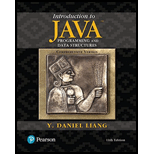
Introduction to Java Programming and Data Structures, Comprehensive Version (11th Edition)
11th Edition
ISBN: 9780134670942
Author: Y. Daniel Liang
Publisher: PEARSON
expand_more
expand_more
format_list_bulleted
Question
Chapter 25.3, Problem 25.3.2CP
Program Plan Intro
Binary search tree:
Binary search tree is a tree; the nodes are sorted in the semantic order.
- Binary search tree has the shape of binary tree.
- Nodes in the binary search tree can have zero, one, or two children.
- In a binary search tree, any node value is greater than the left sub tree and lesser than the right sub tree.
- Node without children is called a leaf or end node.
- A node that does not have a superior node is called a root node.
- Root node is the starting node.
- The binary search will be performed until finding a search node or reaching the end of the tree.
Expert Solution & Answer
Want to see the full answer?
Check out a sample textbook solution
Students have asked these similar questions
Write the SQL code that permits to implement the tables: Student and Transcript. NB: Add the constraints on the attributes – keys and other.
Draw an ERD that will involve the entity types: Professor, Student, Department and Course. Be sure to add relationship types, key attributes, attributes and multiplicity on the ERD.
Draw an ERD that represents a book in a library system. Be sure to add relationship types, key attributes, attributes and multiplicity on the ERD.
Chapter 25 Solutions
Introduction to Java Programming and Data Structures, Comprehensive Version (11th Edition)
Ch. 25.2 - Prob. 25.2.1CPCh. 25.2 - Prob. 25.2.2CPCh. 25.2 - Prob. 25.2.3CPCh. 25.2 - Prob. 25.2.4CPCh. 25.2 - Prob. 25.2.5CPCh. 25.3 - Prob. 25.3.1CPCh. 25.3 - Prob. 25.3.2CPCh. 25.3 - Prob. 25.3.3CPCh. 25.3 - Prob. 25.3.4CPCh. 25.4 - Prob. 25.4.1CP
Ch. 25.4 - Prob. 25.4.2CPCh. 25.4 - Prob. 25.4.3CPCh. 25.4 - Prob. 25.4.4CPCh. 25.4 - Prob. 25.4.5CPCh. 25.5 - Prob. 25.5.1CPCh. 25.5 - Prob. 25.5.2CPCh. 25.5 - Prob. 25.5.3CPCh. 25.5 - Prob. 25.5.4CPCh. 25.5 - Prob. 25.5.5CPCh. 25.6 - Prob. 25.6.1CPCh. 25.6 - Prob. 25.6.2CPCh. 25.6 - Prob. 25.6.3CPCh. 25.6 - How do you replace lines 9499 in Listing 25.11...Ch. 25 - Prob. 25.1PECh. 25 - (Implement inorder traversal without using...Ch. 25 - (Implement preorder traversal without using...Ch. 25 - (Implement postorder traversal without using...Ch. 25 - Prob. 25.6PECh. 25 - Prob. 25.7PECh. 25 - (Implement bidirectional iterator) The...Ch. 25 - Prob. 25.9PECh. 25 - Prob. 25.10PECh. 25 - Prob. 25.11PECh. 25 - (Test BST) Design and write a complete test...Ch. 25 - (Modify BST using Comparator) Revise BST in...Ch. 25 - Prob. 25.15PECh. 25 - (Data compression: Huffman coding) Write a program...Ch. 25 - Prob. 25.17PECh. 25 - (Compress a file) Write a program that compresses...Ch. 25 - (Decompress a file) The preceding exercise...
Knowledge Booster
Similar questions
- 2:21 m Ο 21% AlmaNet WE ARE HIRING Experienced Freshers Salesforce Platform Developer APPLY NOW SEND YOUR CV: Email: hr.almanet@gmail.com Contact: +91 6264643660 Visit: www.almanet.in Locations: India, USA, UK, Vietnam (Remote & Hybrid Options Available)arrow_forwardProvide a detailed explanation of the architecture on the diagramarrow_forwardhello please explain the architecture in the diagram below. thanks youarrow_forward
- Complete the JavaScript function addPixels () to calculate the sum of pixelAmount and the given element's cssProperty value, and return the new "px" value. Ex: If helloElem's width is 150px, then calling addPixels (hello Elem, "width", 50) should return 150px + 50px = "200px". SHOW EXPECTED HTML JavaScript 1 function addPixels (element, cssProperty, pixelAmount) { 2 3 /* Your solution goes here *1 4 } 5 6 const helloElem = document.querySelector("# helloMessage"); 7 const newVal = addPixels (helloElem, "width", 50); 8 helloElem.style.setProperty("width", newVal); [arrow_forwardSolve in MATLABarrow_forwardHello please look at the attached picture. I need an detailed explanation of the architecturearrow_forward
- Information Security Risk and Vulnerability Assessment 1- Which TCP/IP protocol is used to convert the IP address to the Mac address? Explain 2-What popular switch feature allows you to create communication boundaries between systems connected to the switch3- what types of vulnerability directly related to the programmer of the software?4- Who ensures the entity implements appropriate security controls to protect an asset? Please do not use AI and add refrencearrow_forwardFind the voltage V0 across the 4K resistor using the mesh method or nodal analysis. Note: I have already simulated it and the value it should give is -1.714Varrow_forwardResolver por superposicionarrow_forward
- Describe three (3) Multiplexing techniques common for fiber optic linksarrow_forwardCould you help me to know features of the following concepts: - commercial CA - memory integrity - WMI filterarrow_forwardBriefly describe the issues involved in using ATM technology in Local Area Networksarrow_forward
arrow_back_ios
SEE MORE QUESTIONS
arrow_forward_ios
Recommended textbooks for you
 New Perspectives on HTML5, CSS3, and JavaScriptComputer ScienceISBN:9781305503922Author:Patrick M. CareyPublisher:Cengage Learning
New Perspectives on HTML5, CSS3, and JavaScriptComputer ScienceISBN:9781305503922Author:Patrick M. CareyPublisher:Cengage Learning C++ Programming: From Problem Analysis to Program...Computer ScienceISBN:9781337102087Author:D. S. MalikPublisher:Cengage Learning
C++ Programming: From Problem Analysis to Program...Computer ScienceISBN:9781337102087Author:D. S. MalikPublisher:Cengage Learning Operations Research : Applications and AlgorithmsComputer ScienceISBN:9780534380588Author:Wayne L. WinstonPublisher:Brooks Cole
Operations Research : Applications and AlgorithmsComputer ScienceISBN:9780534380588Author:Wayne L. WinstonPublisher:Brooks Cole Systems ArchitectureComputer ScienceISBN:9781305080195Author:Stephen D. BurdPublisher:Cengage Learning
Systems ArchitectureComputer ScienceISBN:9781305080195Author:Stephen D. BurdPublisher:Cengage Learning COMPREHENSIVE MICROSOFT OFFICE 365 EXCEComputer ScienceISBN:9780357392676Author:FREUND, StevenPublisher:CENGAGE L
COMPREHENSIVE MICROSOFT OFFICE 365 EXCEComputer ScienceISBN:9780357392676Author:FREUND, StevenPublisher:CENGAGE L

New Perspectives on HTML5, CSS3, and JavaScript
Computer Science
ISBN:9781305503922
Author:Patrick M. Carey
Publisher:Cengage Learning

C++ Programming: From Problem Analysis to Program...
Computer Science
ISBN:9781337102087
Author:D. S. Malik
Publisher:Cengage Learning

Operations Research : Applications and Algorithms
Computer Science
ISBN:9780534380588
Author:Wayne L. Winston
Publisher:Brooks Cole

Systems Architecture
Computer Science
ISBN:9781305080195
Author:Stephen D. Burd
Publisher:Cengage Learning


COMPREHENSIVE MICROSOFT OFFICE 365 EXCE
Computer Science
ISBN:9780357392676
Author:FREUND, Steven
Publisher:CENGAGE L